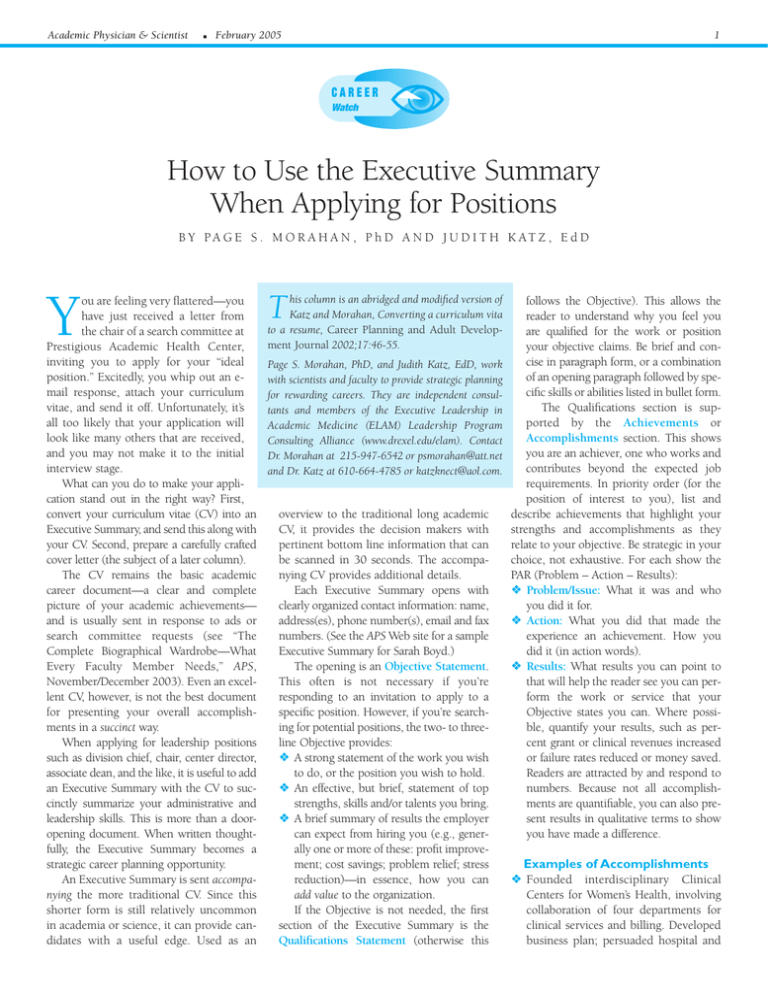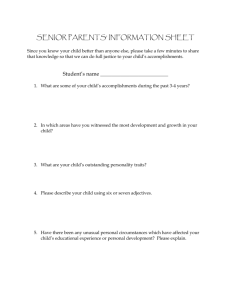Y
advertisement

Academic Physician & Scientist ■ February 2005 1 CAREER Watch How to Use the Executive Summary When Applying for Positions B Y PA G E S . M O R A H A N , P h D A N D J U D I T H K AT Z , E d D Y ou are feeling very flattered—you have just received a letter from the chair of a search committee at Prestigious Academic Health Center, inviting you to apply for your “ideal position.” Excitedly, you whip out an email response, attach your curriculum vitae, and send it off. Unfortunately, it’s all too likely that your application will look like many others that are received, and you may not make it to the initial interview stage. What can you do to make your application stand out in the right way? First, convert your curriculum vitae (CV) into an Executive Summary, and send this along with your CV. Second, prepare a carefully crafted cover letter (the subject of a later column). The CV remains the basic academic career document—a clear and complete picture of your academic achievements— and is usually sent in response to ads or search committee requests (see “The Complete Biographical Wardrobe—What Every Faculty Member Needs,” APS, November/December 2003). Even an excellent CV, however, is not the best document for presenting your overall accomplishments in a succinct way. When applying for leadership positions such as division chief, chair, center director, associate dean, and the like, it is useful to add an Executive Summary with the CV to succinctly summarize your administrative and leadership skills. This is more than a dooropening document. When written thoughtfully, the Executive Summary becomes a strategic career planning opportunity. An Executive Summary is sent accompanying the more traditional CV. Since this shorter form is still relatively uncommon in academia or science, it can provide candidates with a useful edge. Used as an T his column is an abridged and modified version of Katz and Morahan, Converting a curriculum vita to a resume, Career Planning and Adult Development Journal 2002;17:46-55. Page S. Morahan, PhD, and Judith Katz, EdD, work with scientists and faculty to provide strategic planning for rewarding careers. They are independent consultants and members of the Executive Leadership in Academic Medicine (ELAM) Leadership Program Consulting Alliance (www.drexel.edu/elam). Contact Dr. Morahan at 215-947-6542 or psmorahan@att.net and Dr. Katz at 610-664-4785 or katzknect@aol.com. overview to the traditional long academic CV, it provides the decision makers with pertinent bottom line information that can be scanned in 30 seconds. The accompanying CV provides additional details. Each Executive Summary opens with clearly organized contact information: name, address(es), phone number(s), email and fax numbers. (See the APS Web site for a sample Executive Summary for Sarah Boyd.) The opening is an Objective Statement. This often is not necessary if you’re responding to an invitation to apply to a specific position. However, if you’re searching for potential positions, the two- to threeline Objective provides: ❖ A strong statement of the work you wish to do, or the position you wish to hold. ❖ An effective, but brief, statement of top strengths, skills and/or talents you bring. ❖ A brief summary of results the employer can expect from hiring you (e.g., generally one or more of these: profit improvement; cost savings; problem relief; stress reduction)—in essence, how you can add value to the organization. If the Objective is not needed, the first section of the Executive Summary is the Qualifications Statement (otherwise this follows the Objective). This allows the reader to understand why you feel you are qualified for the work or position your objective claims. Be brief and concise in paragraph form, or a combination of an opening paragraph followed by specific skills or abilities listed in bullet form. The Qualifications section is supported by the Achievements or Accomplishments section. This shows you are an achiever, one who works and contributes beyond the expected job requirements. In priority order (for the position of interest to you), list and describe achievements that highlight your strengths and accomplishments as they relate to your objective. Be strategic in your choice, not exhaustive. For each show the PAR (Problem – Action – Results): ❖ Problem/Issue: What it was and who you did it for. ❖ Action: What you did that made the experience an achievement. How you did it (in action words). ❖ Results: What results you can point to that will help the reader see you can perform the work or service that your Objective states you can. Where possible, quantify your results, such as percent grant or clinical revenues increased or failure rates reduced or money saved. Readers are attracted by and respond to numbers. Because not all accomplishments are quantifiable, you can also present results in qualitative terms to show you have made a difference. Examples of Accomplishments ❖ Founded interdisciplinary Clinical Centers for Women’s Health, involving collaboration of four departments for clinical services and billing. Developed business plan; persuaded hospital and 2 Academic Physician & Scientist departments to join the effort that grew the unit from 4 clinics to 10 clinics per week; increased staff from 2 to 12 within 18 months and increased revenues by 30 percent. ❖ Initiated and moderated numerous seminars and product demonstrations for community organizations and clients. Persuaded community leaders to donate time for panel discussion; identified hostile participants and defused conflicting positions; built rapport. Results: Open community forum won acclaim, including excellent local newspaper and radio reviews; three out of eight client companies purchased new software packages. ❖ Developed comprehensive program for delivery of services to students with disabilities. Made services to students with disabilities a priority; engaged groups to design necessary modifications for access. Results: enrolled more than 600 students with disabilities, more than any other college in the area. Page S. Morahan, PhD “When applying for leadership positions, it is useful to add an Executive Summary with the CV to succinctly summarize your administrative and leadership skills.” ❖ Founded Office for Faculty Affairs. Engaged broad faculty/administrative group to design, implement and evaluate the first annual faculty professional development and performance appraisal system for the health sciences university. Results: Materials still in use seven years later, available on Web site, and used as models by other medical schools. ❖ Researched reasons for a financial paper backlog for two accounting departments Example of 1-Page Executive Summary (omitting Experience and Education) Sarah Boyd, PhD 134 Anywhere Avenue Midwest, IL xxxxx T: Home xxx-534-7891 Off. xxx-706-1432 E-mail: Sarah.Boyd@midwest.edu Objective Basic science department chair position, leading and mentoring staff, ensuring departmental goals are met in alignment with medical college, and supporting strong student relations. Qualifications Over ten years of increasingly broad experience in research management; teaching and mentoring graduate students, fellows, staff, faculty; and academic and scientific disciplinary leadership. Accomplishments ❖ Lead multidisciplinary research group in molecular endocrinology of diabetes. Over 15 years of continuous research support totaling $10 million; funded collaborations with clinicians and pharmaceutical industry; patent pending. ❖ Connect/ persuade people to accomplish challenging tasks. Developed Program Project among three institutions, now in 7th year of funding. ❖ Reorganize working groups for more productivity. Designed successful, first-ever department retreat; developed new faculty merit review process, now in third year of implementation. ❖ Innovative problem solver. Redesigned departmental graduate brochure and marketing approach and increased applicants by 35%; increased graduate program funding by dual-adviser role with local pharmaceutical industry; doubled graduate student publication rate through including manuscripts as chapters in PhD dissertations. ■ February 2005 in complex health care organization. Identified problems; assessed internal capabilities; set goals, planned and implemented procedures to correct the problem, reorganized the two inefficient departments into one. Results: Cleared 5000 items and 5-year backlog; reduced staff by 10 employees through natural attrition in less than 15 months; realized savings in excess of $120,000 annually. The Experience section is next. In reverse chronological order, list position title, institution, location, and dates. If you want a longer version of an Executive Summary, amplify each position by describing key functions. Strategically decide whether to emphasize the institution or position by placing that item on the left. Always place the dates on the right (you want to emphasize the positions or places). Last comes the section most academics generally begin with, Education. Advanced training may be included or separated out into a separate Advanced Training section. In reverse chronological order, list formal education and training. There are a few additional sections that might be considered if space permits and they are deemed pertinent for the particular position you are seeking (and might not easily be seen in the CV). These include Affiliations, Honors/Awards, and Grants. Some advanced training may also be honors. Results Using the Executive Summary Over the past few years, several academics who have used Executive Summaries have made comments such as: “Can’t say enough about the impact of sending a shortened resume with the full CV when responding to an advertisement for a job. Just heard from ‘XU’ and will interview at end of month for the Vice Chancellor of Research.” Another said, “This has been a really effective tool because it lets the resume ‘do the talking’ for you; something the CV is not designed to do.” A third said, “When speaking to a ‘headhunter’ screening candidates for an academic deanship, I was told that my materials were so wonderful that many of his questions were answered in the material sent to him, which included an executive summary.” A fourth client recently said that an executive search firm said his Executive Summary “made his application stand out.” ❖




